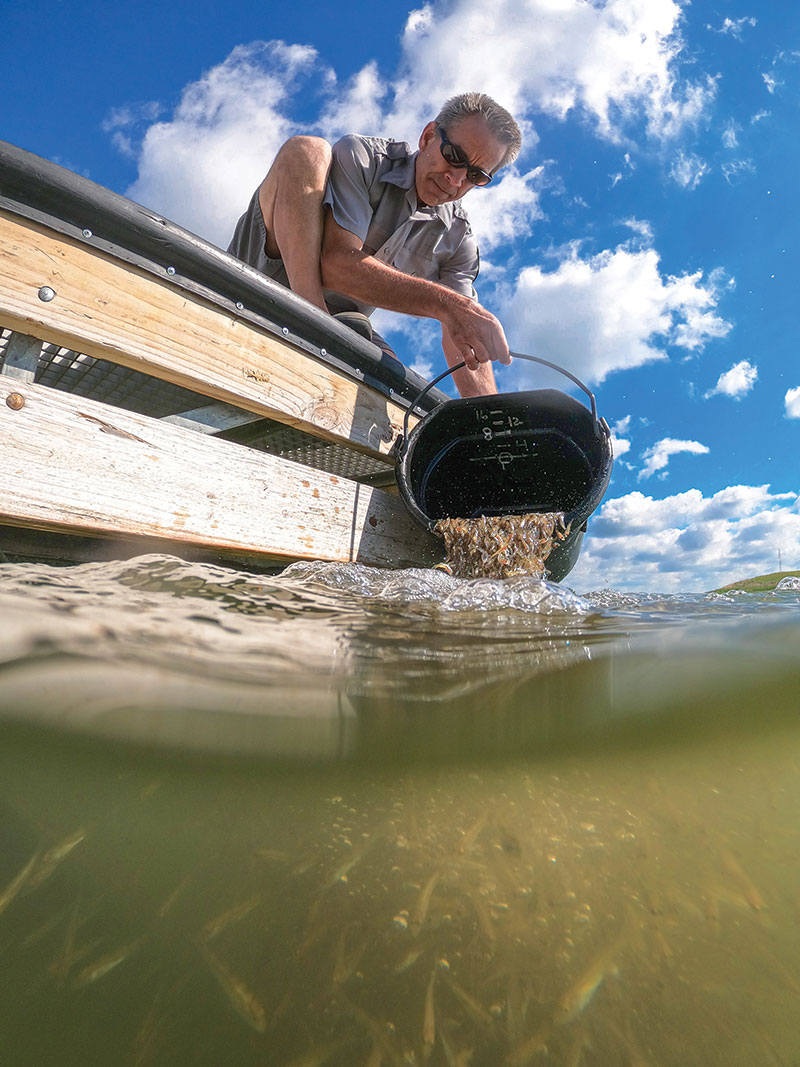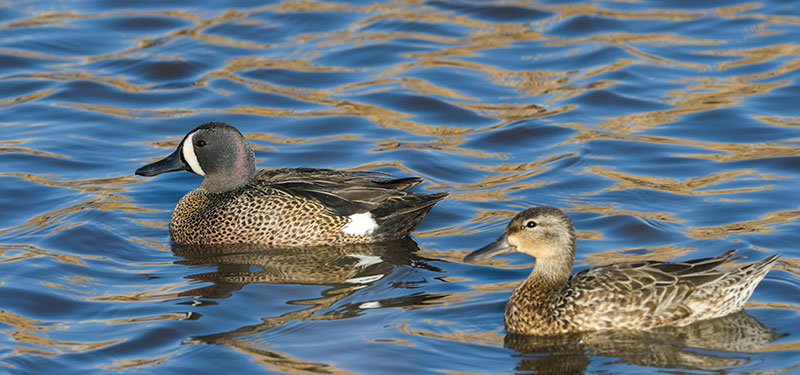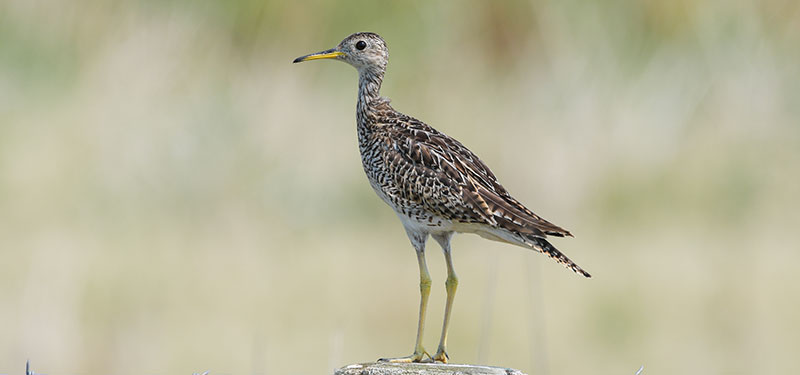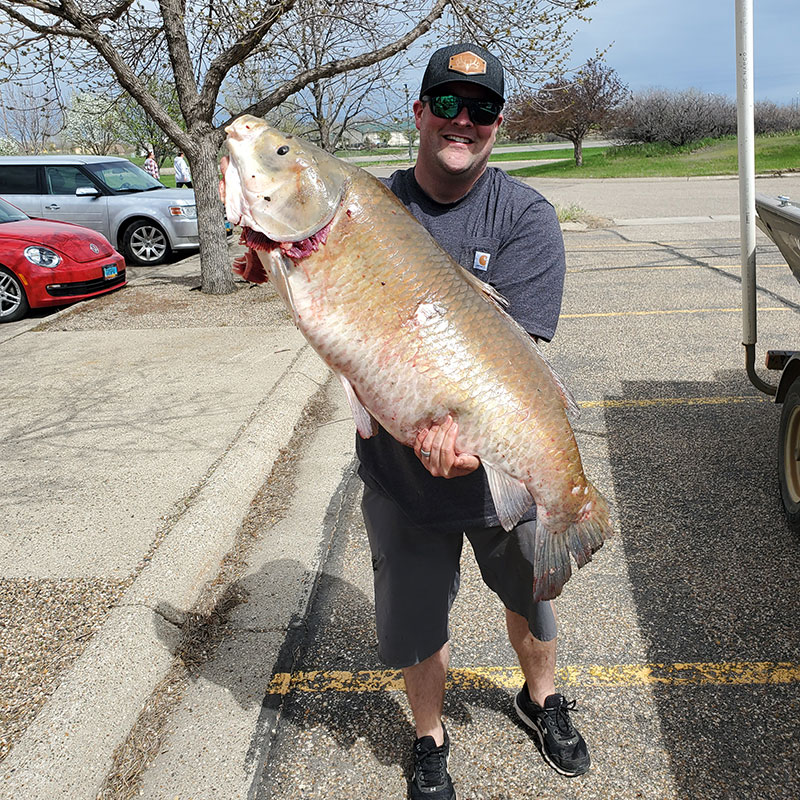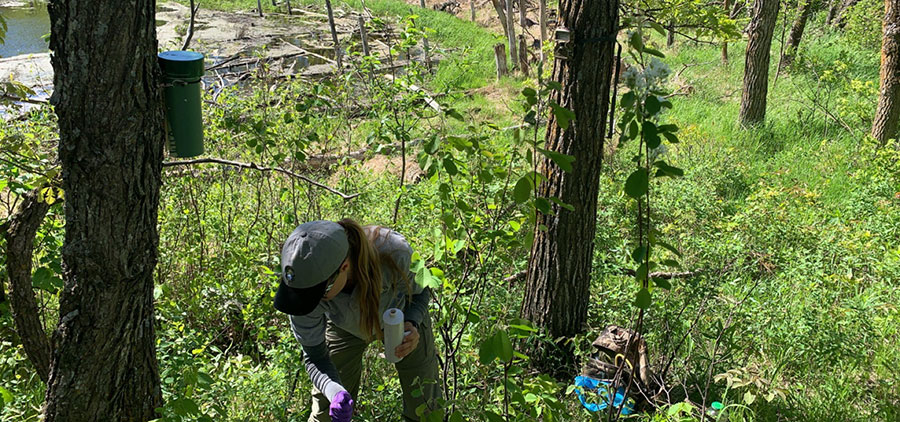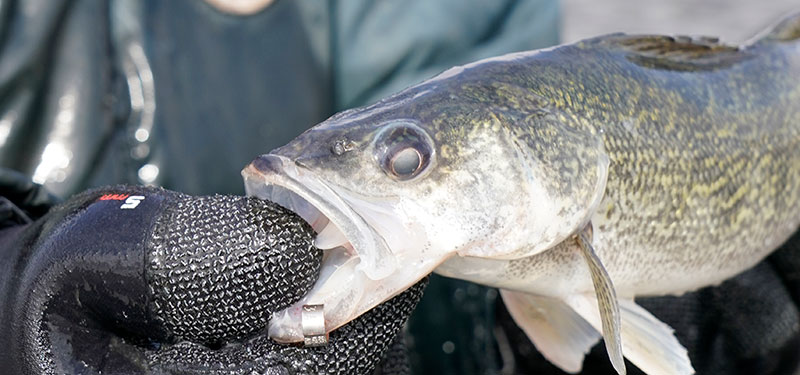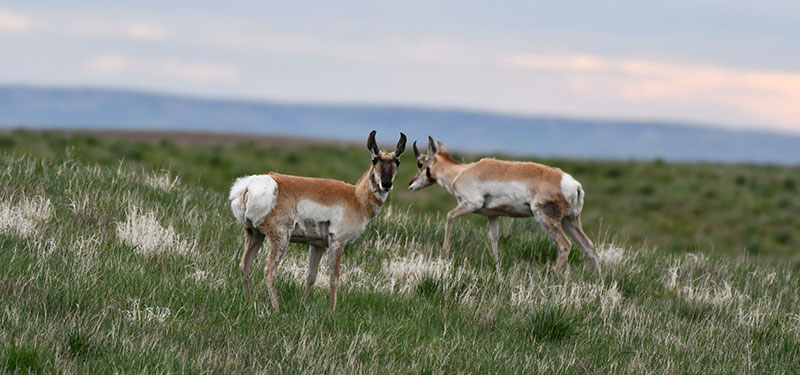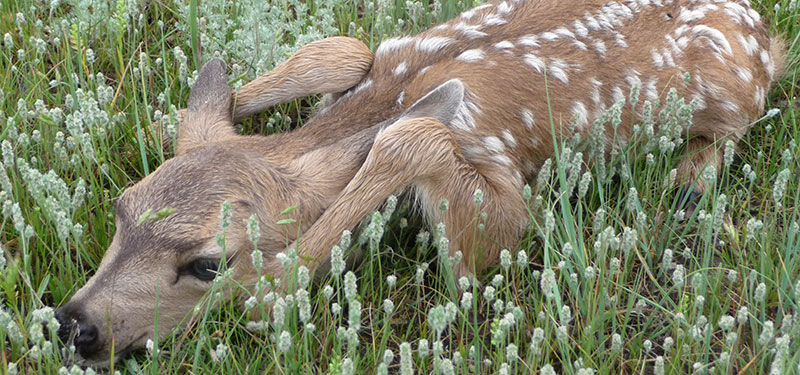The North Dakota Game and Fish Department’s 75th annual spring breeding duck survey conducted in May showed an index of nearly 3.4 million birds, up 16% from last year.
Migratory game bird supervisor Mike Szymanski said the index was the 23rd highest on record and stands 38% above the long-term (1948-2021) average.
Indices for most individual species, with the exception of green-winged teal, gadwall, wigeon and blue-winged teal, increased from 2021. Mallards were up 58% from 2021 and represented the 25th highest count on record. The ruddy duck index increased 157%, shovelers and pintails increased 126% and 108%, respectively, and other increases ranged from 4% for scaup to 69% for canvasbacks. Decreases from the 2021 index were observed for green-winged teal (-42%), gadwall (-36%), wigeon (-10%) and blue-winged teal (-4%).
“It’s important to note that some of our statewide increases in species counts might not reflect broader-scale population trends, especially for pintails,” Szymanski said. “The abnormally wet conditions in the state are likely holding a higher percentage of breeding pintails than normal. We’re coming off a very dry year that resulted in low reproduction, range-wide, for many species.”
The number of temporary and seasonal wetlands was substantially higher than last year, as figures show the spring water index is up 616%, the largest single year increase on record for the survey. The water index is based on basins with water and does not necessarily represent the amount of water contained in wetlands or the type of wetlands represented. Consistent precipitation and cool weather leading up to the survey left a lot of water on the landscape in ditches and intermittent streams.
“Besides being our 75th consecutive survey year, this was an interesting survey, as we’ve gone back and forth between wet and dry conditions over the past couple of years,” Szymanski said. “We actually had our second highest wetland index in the state, which is largely made up of water that’ll dry up fairly quickly. But ponds that are important for brood-rearing habitat have rebounded nicely as well.
“A lot can change between May and hunting season, so we’ll get a few more looks from our July brood index and our September wetland count,” he added. “But duck production should be a little bit better this year than it was last year due to a stronger breeding effort. However, we continue to lose grass in upland nesting sites that will diminish reproductive potential for ducks in the state. Despite expected low Canada goose production this year due to the harsh conditions in April, we did have a record number of geese on breeding territories, so hunting opportunities for those birds should be pretty good again this year.”
Wildlife conservationists in North Dakota and elsewhere applauded the U.S. House of Representatives for passing the bipartisan Recovering America’s Wildlife Act in June, lauding the landmark legislation as the most significant investment in wildlife conservation in a generation.
If approved by the Senate, RAWA will provide unprecedented levels of funding for states, along with tribal nations, to conserve and recover imperiled wildlife and plant species.
According to the Association of Fish and Wildlife Agencies, RAWA would strengthen the nation’s conservation legacy by dedicating $1.3 billion annually for state-level conservation and $97.5 million to tribal nations to recover and sustain healthy fish and wildlife populations. The funds will be used to accelerate the recovery of the more than 12,000 species of greatest conservation need across the country by implementing strategies identified in each state’s federally approved State Wildlife Action Plan.
If approved as is, it’s estimated that North Dakota could receive about $15 million annually in dedicated wildlife funding.
Jeb Williams, North Dakota Game and Fish Department director, said that while RAWA passing the House was momentous, he understands the hurdles the bill must clear to become reality.
“The Senate will now be the next step in the process and discussion continues amongst leadership on the importance of this funding,” he said.
Wildlife managers, Williams said, understand that listing a species as federally threatened or endangered may restrict or intensify certain actions on private and public lands. The cost of protection or restoration of a listed species is often far greater than preventing or stemming the decline in the first place.
“We have 115 species of conservation priority in North Dakota and the backbone of RAWA is to give extra attention to those species so they don’t become threatened or endangered,” he said. “Recovering America’s Wildlife Act is a state wildlife grant on steroids and the funding will certainly provide us the opportunity in North Dakota to keep that from happening.”
A bow fisherman from Bismarck has set a new bow/spear state record.
Mitch Estabrook arrowed a 60-pound, 8-ounce buffalo from Heart Butte Reservoir on May 16. It broke the previous record by 3 pounds, taken at Heart Butte Reservoir in 2017 by Derek Larson of Mandan.
Buffalo are a native fish sometimes confused with nonnative and invasive common carp. North Dakota Game and Fish Department records indicate that Estabrook’s fish is the largest weighed in the state that was not a paddlefish or pallid sturgeon.
Archery Hunters Plan for Licenses
The North Dakota Game and Fish Department reminds archery hunters to plan accordingly and allow for time to receive their bow tag in the mail as hunters will not receive their tag immediately after purchase.
Bow licenses can still be purchased at license vendors, but like last year the tag will arrive by postal mail, not over the counter while the customer waits. This applies while purchasing a bow license at a license vendor, or at the Game and Fish Department’s main office in Bismarck.
The bow tag will be mailed the next business day after the bow license is purchased. All archery hunters must have the bow tag in their possession before hunting.
Bow licenses can also be purchased online by visiting My Account.
The North Dakota Game and Fish Department has for years encouraged students to design Earth Day patches to bring greater awareness to the environment in the state and elsewhere.
Yet, like Earth Day, which began in 1970 and kicked-started the environmental movement, the concern for our outdoor places isn’t simply a once-a-year-thing, but ongoing.
Understanding this, the Game and Fish Department has initiated Earth Day, Every Day to promote continual awareness about the environment.
Groups that engage in environmental clean-up projects, landscaping, or other efforts that promote environmental awareness, will receive an Earth Day patch for all participants.
The patches are used to recognize groups that work to celebrate the Earth Day concept, and everyone is encouraged to participate in the Earth Day, Every Day awareness campaign.
For more information about Earth Day, Every Day, or to request patches for your project, contact Sherry Niesar, Earth Day coordinator, at 701-527-3714.
Cami Wight, North Dakota Game and Fish Department lab technician (pictured) and Ryan Herigstad, Department game management technician, set cubby sets for pine martens across the Turtle Mountains in June as part of a three-year study with Michigan State University.
The goal of the study, which is in its first year, is to help assess prevalence, distribution and genetic variance of pine martens in the Turtle Mountains.
The cubby sets were baited with beaver meat, salmon oil was used as lure on the base of the tree, and sticky pads were strategically placed to collect marten hair samples.
Cameras were also placed at each site.
Anglers can help fisheries managers by reporting information on tagged fish.
Most tagged fish in North Dakota, except salmon, will have either a metal tag on the jawbone or a small tag attached near the dorsal fin. Tagged salmon have their adipose fin removed and also have a microscopic, coded wire tag embedded in their head. Anglers are asked to drop their tagged salmon heads off at Game and Fish offices in Riverdale or Bismarck so that biologists can remove the tag and read it.
North Dakota Game and Fish Department fisheries biologists say it’s imperative anglers report tagged fish from whatever waters they are fishing in, no matter if they end up in livewells or back in the lake. Anglers are also encouraged to treat tagged fish just like they would treat any other fish they might have caught. Anglers practicing catch-and-release should record the tag number before releasing the fish.
Anglers are asked to record the tag number and report that along with the date and location the fish was caught, approximate size and whether the fish was harvested or released. Tagged fish can be reported online, or call the Department’s main office in Bismarck at 701-328-6300.
The North Dakota Game and Fish Department encourages boaters to plan accordingly when launching and loading a boat. Here are a few simple reminders to ensure a fluent transition at the ramp.
Launching
- Don’t pull onto the ramp until your boat is ready to launch.
- Prepare for launching in the parking area. Remove covers, load equipment, remove tie downs, attach lines and put in drain plug before backing onto the ramp.
- When ready, pull in line to launch. Wait your turn. Be courteous.
Loading
- Don’t block the loading area with your boat until your tow vehicle is ready to load. Wait until you are clear of the launch area to unload gear.
- As soon as your trailer is in the water, load and secure your boat to the trailer.
- Remove boat and trailer from the water as quickly as possible.
Get clear of the ramp. Pull into the parking area to finish securing your boat, unload gear, drain all water and inspect for and removing any vegetation. Remember to leave plugs out when transporting your boat.
The North Dakota Game and Fish Department’s annual aerial pronghorn survey began in early July and will determine pronghorn abundance, herd demographics and fawn production.
This data, which was not available at publication, is used to set the number of licenses for the fall hunting season.
North Dakota boaters traveling to or through other states or Canadian provinces, are reminded to check the aquatic nuisance species regulations of their destination.
Mandatory boat inspections may be required along highways or at lakes based on destination or route taken. In general, to ensure compliance, boaters are strongly encouraged to clean, drain and dry equipment.
- CLEAN: remove plants, animals and excessive mud from trailers, hulls, motors and other equipment such as fishing rods.
- DRAIN: drain all water, including bilges, livewells and bait buckets.
- DRY: allow all equipment to dry completely, as an inspection might fail in a neighboring state if any standing water is present. If necessary, use sponges or towels to remove excess water and leave compartments open to dry.
More information on bordering state and provincial ANS regulations is available at the following web addresses.
The North Dakota Cooperative Fur Harvester Education Program is hosting fur harvester education classes on Aug. 2, 4, and 6 at the North Dakota Game and Fish Department in Bismarck and Oct. 6, 7, and 8 at the Velva Wildlife Club in Velva.
Fur harvester education classes are 16 hours in length, free, voluntary, and cover topics associated with trapping and fur hunting. Much of the instruction includes hands-on experience with traps and equipment commonly used for harvesting furbearers and properly caring for the pelts.
Successful completion of this training provides certification, which is recognized by other states where mandatory trapper education training is required. Participants can enroll for either of these classes online.
The North Dakota Cooperative Fur Harvester Education Program is also hosting a Using Cable Devices in North Dakota training seminar on Oct. 15 from 9 a.m. to 4 p.m. at the Velva Wildlife Club.
The seminar is free and available to anyone who would like information and experience using cable devices. All aspects of cable device construction, care, use, ethics, responsibility, and legal requirements are covered. Much of the instruction includes hands-on field application and set construction. Preregistration is required by contacting Rick Tischaefer at 701-460-1055.
Regardless of how safe and cautious boaters are on the water, accidents happen. If a boating accident involves injury, death or disappearance of a person, an accident report must be completed and sent to the North Dakota Game and Fish Department within 48 hours of the occurrence.
If property damage exceeds $2,000, but no deaths or injuries occur, a boat operator has five days to file a report.
These reporting requirements are mandatory whether there is one or more boats involved.
A boat accident form is available online, at any Game and Fish office or by contacting a local game warden.
Photographers interested in sending photos for the North Dakota Game and Fish Department’s Watchable Wildlife Photo Contest are reminded to follow the guidelines for submitting their work.
Photographers should go to the Game and Fish Department’s website. Then it is a matter of providing some pertinent information about the photo and uploading it. Doing so helps both with ease of submitting photos for the photographer and managing those images for Department staff.
The contest is now open and the deadline for submitting photos is Oct. 3. For more information or questions, contact Patrick Isakson, Department conservation biologist, at pisakson@nd.gov.
The contest has categories for nongame and game species, as well as plants/insects. An overall winning photograph will be chosen, with the number of place winners in each category determined by the number of qualified entries.
Contestants are limited to no more than five entries. Photos must have been taken in North Dakota.
By submitting an entry, photographers grant permission to Game and Fish to publish winning photographs in North Dakota OUTDOORS, and on the Department’s website.
North Dakota state law requires youth ages 12-15 who want to operate a boat or personal watercraft by themselves with at least a 10-horsepower motor must pass the state’s boating basics course.
The course is available for home-study by contacting the North Dakota Game and Fish Department at 701-328-6300. Two commercial providers also offer the course online, and links to those sites are found on the boat and water safety education page.
While the home-study course is free, students are charged a fee to take it online. The online provider charges for the course, not the Game and Fish Department. The fee remains with the online provider. The course covers legal requirements, navigation rules, getting underway, accidents and special topics such as weather, rules of the road, laws, lifesaving and first aid.
The North Dakota Game and Fish Department offers a simple message to the well-intentioned who want to pick up and rescue what appear to be orphaned baby animals this time of year: don’t touch them. Whether it is a young fawn, duckling, cottontail rabbit or a songbird, it is better to leave them alone.
Often, young animals are not abandoned or deserted, and the mother is probably nearby. Young wildlife are purposely secluded by adults to protect them from predators.
Anytime a young wild animal has human contact, its chance of survival decreases significantly. It’s illegal to take wild animals home, and captive animals later returned to the wild will struggle to survive without possessing learned survival skills.
The only time a baby animal should be picked up is if it is in an unnatural situation, such as a young songbird found on a doorstep. In that case, the young bird can be moved to the closest suitable habitat.
Citizens should also steer clear of adult wildlife, such as deer or moose that might wander into urban areas. Crowding stresses animals and this can lead to a potentially dangerous situation.
In addition, motorists are reminded to watch for deer along roadways. During the next several weeks young animals are dispersing from home ranges, and with deer more active during this time, the potential for car deer collisions increase.
The state Game and Fish Department reminds anglers that live white suckers are not legal baitfish anywhere in North Dakota, except in the Bois de Sioux and Red rivers.
Anglers can use live white suckers on the Bois de Sioux and Red rivers, and tributaries up to the first vehicular bridge; however, they are illegal elsewhere. Fathead minnows, sticklebacks and creek chubs are the only legal live baitfish outside of the Bois de Sioux and Red rivers.
The transportation of live white suckers, other than in Richland, Cass, Traill, Grand Forks, Walsh and Pembina counties, is illegal.
For more information, refer to the 2022-24 North Dakota Fishing Guide.
Anglers are reminded that it is illegal to import minnows and other forms of live aquatic bait, such as leeches and frogs, into North Dakota.
When purchasing live aquatic bait, anglers must buy from a licensed North Dakota retail bait vendor. Bait vendors can properly identify species and ensure all bait is clean of any aquatic nuisance species.
For more information, refer to the 2022-24 North Dakota Fishing Guide.
The North Dakota Game and Fish Department reminds outdoor recreationists to keep it clean this summer by packing out all trash.
All garbage, including used fireworks, should be placed in a proper trash receptacle. If trash cans aren’t available, or full, dispose of trash at home.
It is not uncommon to see garbage piling up around full trash containers. Styrofoam containers are not biodegradable, but are often found wedged in cattails, drifting or washed up on shore.
Tires, mattresses and kitchen appliances have found their way to public use areas. This illegal dumping is costly to clean up and takes a significant toll on the environment. Not only does it spoil the beauty of the land, it destroys habitat, has the potential to pollute North Dakota waters and can injure wildlife.
Jerry Weigel, Department production/development section supervisor, releases hatchery raised walleye into Lake Sakakawea in late June. The Department stocked roughly 10 million walleye fingerlings in about 170 waters around the state this summer.
